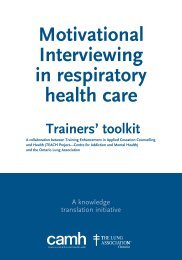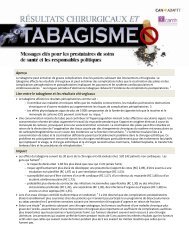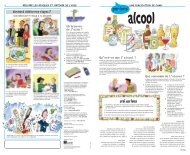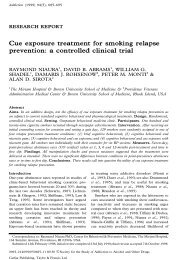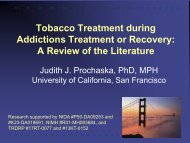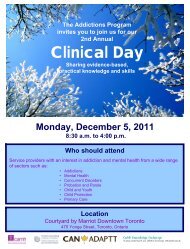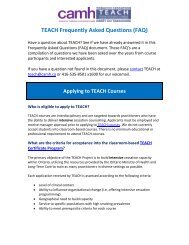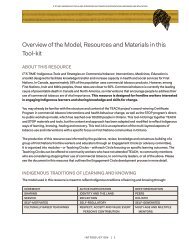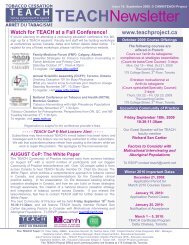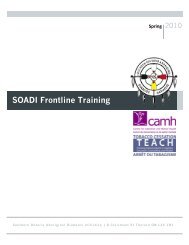Canadian Smoking Cessation Clinical Practice Guideline
Canadian Smoking Cessation Clinical Practice Guideline
Canadian Smoking Cessation Clinical Practice Guideline
You also want an ePaper? Increase the reach of your titles
YUMPU automatically turns print PDFs into web optimized ePapers that Google loves.
CANADIAN SMOKING CESSATION GUIDELINEFORMAT OF GUIDELINEThe guideline is organized into the following sections:<strong>Clinical</strong> ApproachesCounselling & Psychosocial ApproachesPharmacotherapy (in progress using adifferent guideline developmentmethodology)Specific PopulationsAboriginal PeoplesHospital Based PopulationsMental Health and/or Other Addiction(s)Pregnant & Breastfeeding WomenYouth (Children & Adolescents)Each section of the guideline is divided into thefollowing sub-sections:1. Overview of Evidence includes therecommendations and supporting evidenceextracted from relevant pre-existing highquality CPGs, which have contributed to theCAN-ADAPTT summary statements.2. Summary Statements are based on the bestevidence identified, and are the importantmessages for health care providers to considerimplementing in practice. Each SummaryStatement includes the Grade ofRecommendation and Level of Evidencesupporting the Statement.3. <strong>Clinical</strong> Considerations is informationsupporting the Summary Statements, such ashow to best implement the Statements,important implications for specific practicesettings and key considerations. <strong>Clinical</strong>Considerations were informed by the input ofthe <strong>Guideline</strong> Development Group and CAN-ADAPTT Network Members. It was notinformed by a systematic review of theliterature.4. Tools and Resources provides a list ofresources that health care providers can use tohelp implement the Summary Statements. Thelists are not intended to be comprehensive; theyare a starting point informed by the <strong>Guideline</strong>Development Group and CAN-ADAPTTNetwork Members.5. Research Gaps describes any gaps in theevidence and recommendations for futureresearch in the area. See the CAN-ADAPTTResearch Agenda for more information 7 .CLARIFICATION AND LIMITATIONSIn this document, the term “tobacco” refers tomanufactured, commercial tobacco productsincluding, but not limited to, cigarettes, smokelesstobacco such as snuff, snus, and chewing tobacco, andcigars. Tobacco misuse does not refer to tobacco usefor traditional or ceremonial purposes by AboriginalPeoples.Most research in the area of smoking cessation hasexamined cigarette use; it is important to note thislimitation when using this guideline with smokelesstobacco users. More research is needed on smokelesstobacco products and the people who use smokelesstobacco to understand the impact of smokingcessation interventions.The term patient/client is used throughout thisguideline to reflect the diverse clinical settings wheresmoking cessation treatment is provided. The termhealth care provider is used throughout and isintended to reflect a broad range of providers in arange of different settings, including hospital, clinic,home care, acute, community, primary and long termcare.INTRODUCTION 3




